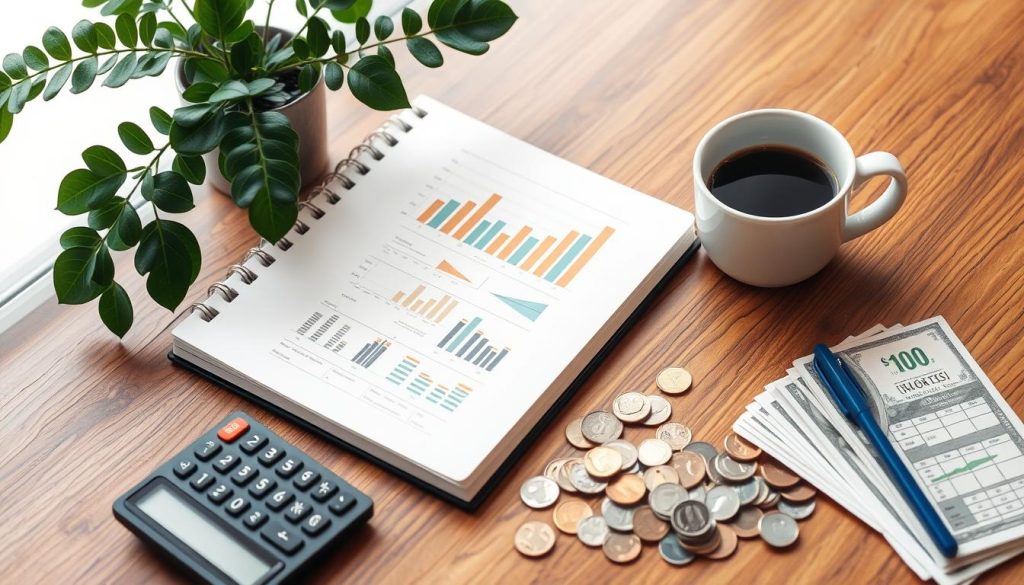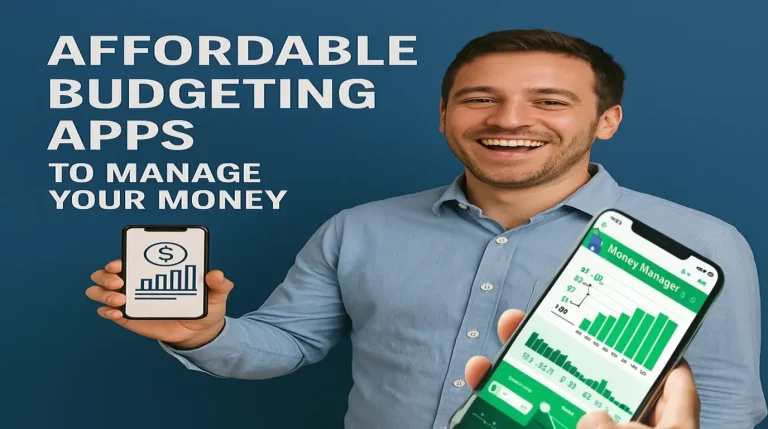How to Create a Monthly Budget
Creating a monthly budget is key to financial stability. It helps you see how much money you have and how you spend it. This way, you can plan for your financial goals.
A good budget lets you manage your spending and save for emergencies. It also helps you reach your long-term financial goals. This is important for staying financially stable.
The budgeting process starts with tracking your income and expenses. Then, you categorize your spending. Finally, you adjust your budget to make sure you don’t spend more than you earn.
The Bureau of Labor Statistics says the average American household spent $72,967 in 2022. Housing costs about 33% of this. This shows why it’s crucial to budget for all expenses, like housing, utilities, groceries, and entertainment.
By following a monthly budget, you can make smart financial choices. You can also prioritize your spending. This helps you achieve financial stability.
In this article, we’ll show you how to make a monthly budget. We’ll cover the basics, steps to follow, and tips to stay on track. By the end, you’ll know how to create a budget that fits your needs and helps you achieve financial stability.
Understanding the Basics of Monthly Budgeting
Creating a monthly budget is key for good financial planning. It shows how to spend and save money each month. You need to know your income, expenses, and goals. A budget helps manage your money, making it easier to reach your goals.
A budget includes expense tracking. This means watching and writing down all your expenses. It’s about fixed costs like rent and car insurance, and variable costs like food and fun. Tracking your spending helps you find ways to save money and adjust your budget.
Having a budget helps you decide how to spend your money wisely. It keeps you from getting into debt and helps you save. By following budgeting basics and focusing on financial planning, you can control your finances and reach your goals.
Knowing the value of expense tracking and budgeting basics lets you make a budget that fits you. It’s about setting achievable goals, tracking your spending, and tweaking your budget when needed. With a good budget, you can secure your financial future and move closer to your long-term dreams.
How to Make a Proper Monthly Budget: Step-by-Step Process
To create a proper monthly budget, you need to follow certain budgeting steps. Start by calculating your total monthly income from all sources. This is the first step to making a realistic budget.
Next, list all your monthly expenses, including both fixed and variable costs. This helps you see where your money goes and find ways to save.
Then, categorize your spending into different areas like housing, transportation, and food. This expense categorization shows which parts of your budget need more focus. By following these budgeting steps, you can make a budget that fits your financial needs and goals.
Remember, a successful budget needs regular checks and adjustments. Keep an eye on your income calculation and expense categorization. This way, you can stay on track with your financial goals and make changes when needed.
Essential Categories to Include in Your Budget
When making a budget, it’s key to cover all budget categories. The U.S. Department of Labor Statistics shows housing is the biggest expense in 2023. So, make sure to budget for housing, transportation, food, insurance, and entertainment.
Good expense tracking and financial planning mean knowing these categories well. For example, housing costs include fixed things like mortgage or rent, and variable costs like utilities. Transportation expenses have fixed parts like car loans and variable parts like gas.
By including these key categories in your budget, you manage your money better. This helps you reach your financial goals. Always check and update your budget to match your changing needs and expenses.
Digital Tools and Apps for Budget Management
Managing your money well is key to financial stability. Thanks to technology, many digital tools and apps help with budgeting. They make it easy to track spending, plan budgets, and set financial goals. Financial management is now easier and more user-friendly, thanks to these apps and tools.
Popular apps like YNAB, Goodbudget, and EveryDollar are great for managing money. YNAB offers a 34-day free trial and then costs $14.99 a month or $109 a year. Goodbudget has a free version for one account and two devices, and its paid version is $10 a month or $80 a year. EveryDollar’s basic version is free, and its premium version is $79.99 a year or $17.99 a month.
Other tools, like spreadsheet templates and banking tools, also help with budgeting. They offer a traditional way to budget and can be tailored to fit your needs. Using these digital tools and apps lets you manage your finances better and make smart money choices.
Popular Budgeting Apps
When picking a budgeting app, think about cost, features, and what others say about it. Apps like Empower Personal Dashboard and PocketGuard are free, while Monarch charges a monthly or yearly fee. By looking at different options, you can find the best app for you and improve your money management skills.
Common Budgeting Challenges and Solutions
Creating a budget can be tough, and many struggle with budgeting challenges. The U.S. has over $5 trillion in personal debt, with $1.32 trillion in revolving debt. This shows the need for good budgeting solutions to beat financial obstacles.
One big budgeting challenge is overspending. The 50/30/20 rule helps by setting aside 50% for needs, 30% for wants, and 20% for savings. Tracking spending for three months also helps spot where to cut back and save better.
The envelope method is another smart budgeting solution. It lets you use cash for different spending areas. This can cut spending by up to 30% compared to other methods. Using these strategies can help overcome financial obstacles and secure a stable financial future.
Tips for Sticking to Your Monthly Budget
Creating a budget is just the first step. Sticking to it needs financial discipline and a solid plan. To do this, set realistic goals, build an emergency fund, and do regular budget reviews. These budgeting tips help you control your money and reach your goals.
Setting achievable targets is key to budgeting success. You need to look at your income, expenses, and goals to make a plan. This way, you can use your money wisely, making sure it serves a purpose. Also, regular budget reviews help keep you on track, letting you see how you’re doing and make changes if needed.

Building an emergency fund is also crucial. It acts as a safety net for unexpected costs, keeping you out of debt and on track with your goals. With a solid emergency fund and regular budget reviews, you can handle financial ups and downs confidently.
The secret to good budgeting is finding a balance between budgeting tips, financial discipline, and being flexible. By keeping this balance and sticking to your goals, you can beat budgeting challenges and achieve financial success in the long run.
Conclusion: Taking Control of Your Financial Future
Creating a detailed monthly budget is key to long-term financial health. It helps you track your income, expenses, and savings. This way, you can control your financial future and move closer to your goals.
Regular budgeting lets you handle daily money matters and build an emergency fund. It also prepares you for unexpected money issues. With tools like budgeting apps and the 50/30/20 rule, anyone can make a budget that fits their life.
Budgeting is an ongoing journey. It might take time to find what works for you. But with effort and regular budget checks, you can reach financial stability, budgeting success, and financial freedom.
FAQ
What is a monthly budget?
A monthly budget is a plan for how you spend and save money each month. It shows your income, expenses, and financial goals.
Why is monthly budgeting important?
Budgeting each month is key to financial stability. It lets you see how much money you have and how you spend it. This helps you reach your financial goals.
What are the key components of a monthly budget?
A monthly budget has a few main parts. First, you calculate your total monthly income. Then, list all your monthly expenses. Next, categorize your spending. Finally, set financial goals.
How do I create a proper monthly budget?
To make a good monthly budget, follow these steps. First, figure out your total monthly income. Next, list all your monthly expenses. Then, sort your spending into categories. Finally, set financial goals.
What are the essential categories to include in a monthly budget?
Important categories for a monthly budget are housing, transportation, food, insurance, and entertainment.
What digital tools and apps are available for budget management?
Many digital tools and apps help with budgeting. You can find popular budgeting apps, spreadsheet templates, and banking tools for tracking expenses.
What are some common budgeting challenges and solutions?
Budgeting challenges include overspending, lack of discipline, and unexpected costs. To solve these, set realistic goals, save for emergencies, and check your budget often.
How can I stick to my monthly budget?
To stay on track with your budget, set achievable goals, save for emergencies, and check your budget regularly.







